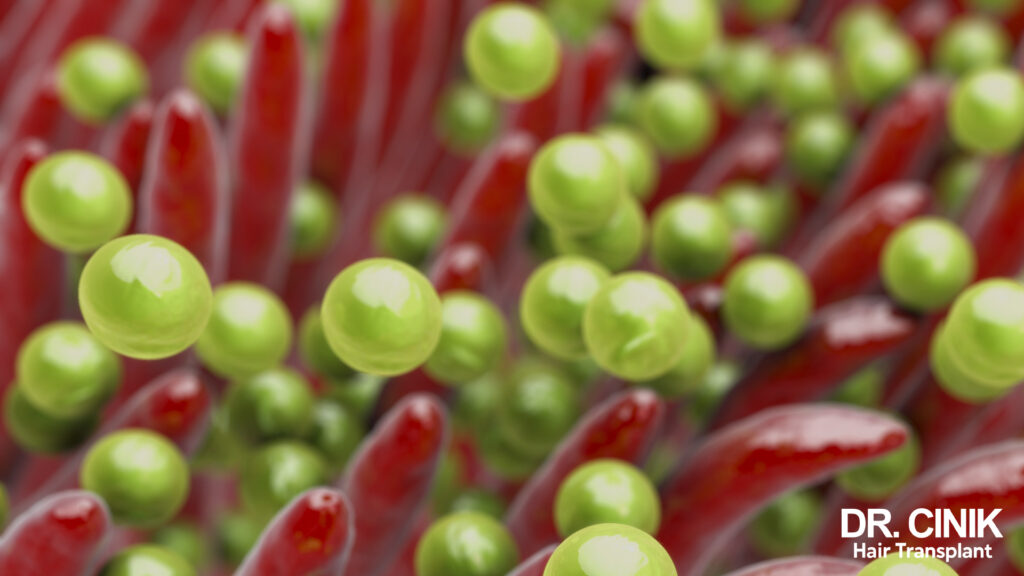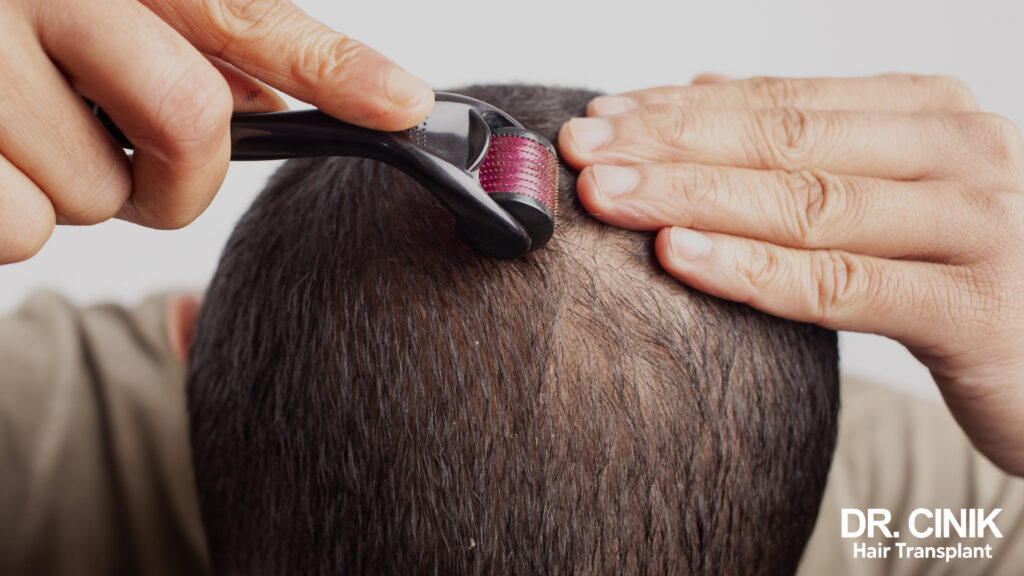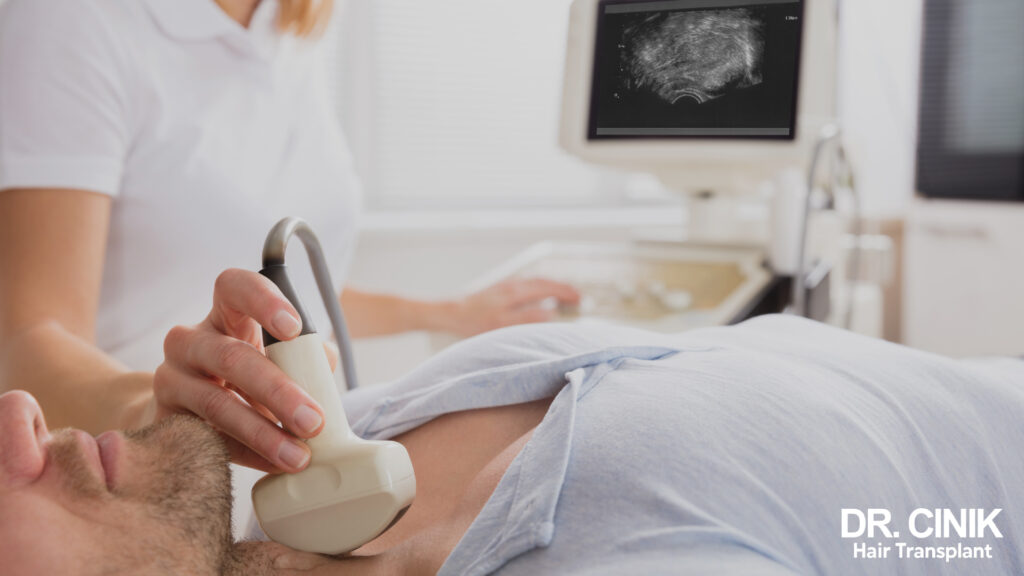Endometriosis and Hair Loss: Understanding and Treating the Problem

Sommaire
Endometriosis, a common gynaecological condition, affects between 2% and 10% of women of childbearing age (Shigesi et al., 2019). This chronic disease, long underdiagnosed, manifests through various symptoms, some of which remain relatively unknown to the public. Among these manifestations, hair loss is a particularly concerning issue, affecting nearly 30% of women with endometriosis (Mehedintu et al., 2014).
This complex pathology is characterised by the abnormal presence of endometrial tissue outside the uterine cavity. Common locations for these ectopic implants include the ovaries, ovarian fossa, utero-sacral ligaments and posterior cul-de-sac (Mehedintu et al., 2014). These implants, reacting to hormonal variations in the menstrual cycle, cause significant imbalances in the body. Such hormonal disturbances can substantially impact hair health, leading to changes in hair texture and, in some cases, significant hair loss (Grymowicz et al., 2020).

The psychological impact of this hair loss should not be underestimated. Beyond the pain and difficulties already caused by endometriosis, hair loss can considerably affect patients’ self-esteem and quality of life. This situation requires comprehensive, personalised care.
Recent medical advances offer promising solutions to this problem. These include the Direct Hair Implantation (DHI) technique, an innovative treatment option particularly suited to women affected by this form of hair loss. This modern technique enables the natural and lasting restoration of hair, restoring confidence to patients affected by this manifestation of endometriosis.
The Link Between Endometriosis and Hair Loss
Hormonal Impact of Endometriosis on Hair
The mechanism linking endometriosis to hair loss is complex and multifactorial. At the heart of this problem lies a significant hormonal imbalance which directly affects the hair growth cycle. Endometriosis causes a disruption in the production and regulation of sex hormones, creating an environment unfavourable to hair health (Owecka et al., 2024).

Androgens, male hormones naturally present in women but in limited quantities, are often found in excess in the context of endometriosis. This overproduction can lead to progressive miniaturisation of hair follicles, particularly visible in the scalp. Oestrogens, female hormones essential for hair growth, also fluctuate significantly, disrupting the natural hair growth cycle (Owecka et al., 2024).
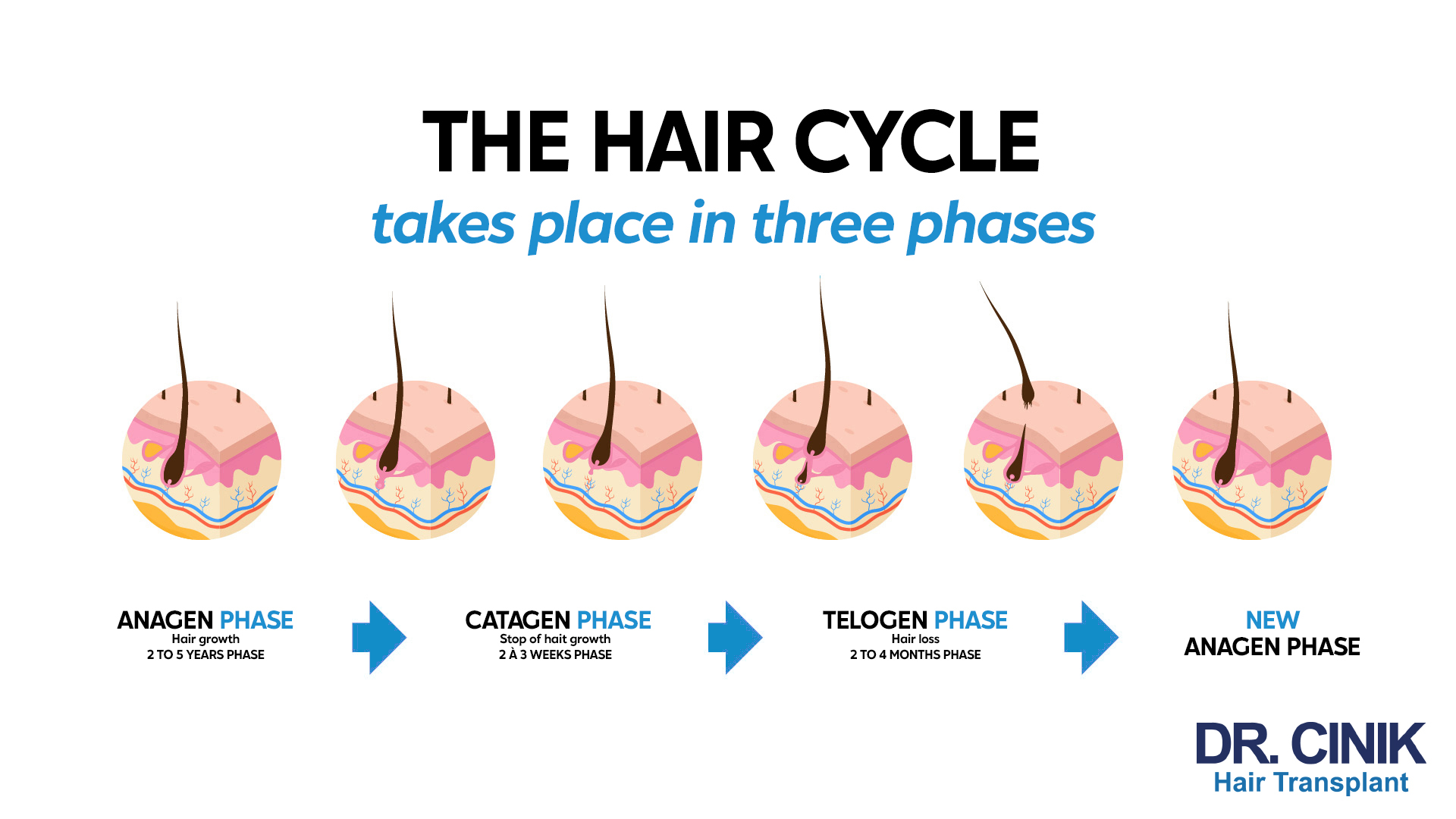
The balance of progesterone, another key hormone in this process, is disturbed by endometriosis. Its protective role on hair follicles is diminished, leading to increased hair loss. Sex Hormone Binding Globulin (SHBG), a protein that regulates sex hormones, also plays a role. Its reduction in the context of endometriosis increases the quantity of circulating free hormones, amplifying their negative impact on hair follicles (Shigesi et al., 2019).
Types of Hair Loss Observed
In the context of endometriosis, two main types of hair loss are observed, each with specific characteristics and mechanisms of action. Understanding these different types of hair loss enables better therapeutic management.
Female androgenetic alopecia is the most common form of hair loss in women with endometriosis. This form is characterised by a progressive thinning of the hair, particularly visible at the top of the head. Unlike male pattern baldness, the hairline generally remains intact. The process begins with a gradual reduction in hair diameter, becoming thinner and shorter with each growth cycle. This progressive miniaturisation of hair follicles leads to a visible reduction in hair density (Mehedintu et al., 2014).

Telogen effluvium, the second major type of hair loss, is more abrupt and diffuse. This form of hair loss often occurs in response to the physical and hormonal stress caused by endometriosis. The hair enters a resting (telogen) phase prematurely, causing significant hair loss a few months later. Although dramatic, this form of hair loss is generally reversible when the underlying cause is effectively treated (Grymowicz et al., 2020).
Impact of Treatments for Endometriosis
The various therapeutic approaches used to treat endometriosis can themselves influence hair health. Hormonal treatments, the mainstay of endometriosis treatment, have varying effects on hair.
Progestins, which are frequently prescribed, can in some cases slow hair loss thanks to their anti-androgenic action. However, GnRH analogues, used in severe forms of endometriosis, create a state of artificial menopause which can temporarily worsen hair loss. Hormonal contraceptives, another common treatment option, have variable effects depending on their composition and the patient’s hormonal profile (Shigesi et al., 2019).

Chronic stress related to the disease and its treatment is an additional aggravating factor. Prolonged elevation of the stress hormone cortisol can disrupt the hair cycle and encourage hair loss. Surgical procedures, sometimes necessary in the treatment of endometriosis, can also have a temporary impact on hair health due to the physiological stress they place on the body (Owecka et al., 2024).
Therapeutic Solutions
Conventional Medical Therapies
The management of hair loss associated with endometriosis requires a comprehensive and personalised approach. Conventional medical treatments are often the first line of defence against this manifestation of the disease.
The reference treatment is topical minoxidil, available as a 2% or 5% solution. Its vasodilatory action stimulates scalp microcirculation and encourages hair regrowth. Anti-androgens, such as spironolactone, can be prescribed to counteract the harmful effects of male hormones on hair follicles. These treatments must be tailored to each patient’s specific hormonal profile and require regular monitoring (Mehedintu et al., 2014).
Specific nutritional supplements also play an important role in maintaining hair health. B vitamins, zinc, iron and essential amino acids help to optimise the hair growth cycle and strengthen hair structure (Grymowicz et al., 2020).

Hormonal Management
Hormonal management is a crucial aspect of treating endometriosis-related hair loss. This approach requires close collaboration between gynaecologists and endocrinologists to optimise overall hormonal balance.
Hormonal balancing begins with a precise assessment of the patient’s hormonal profile. Detailed blood tests measure oestrogen, progesterone, androgen and SHBG levels. This information guides the choice of the most appropriate treatments. Correction of hormonal imbalances may involve the use of specific anti-androgen treatments or bio-identical hormones, always as part of rigorous medical monitoring (Shigesi et al., 2019).
Regular endocrinological monitoring allows treatments to be adjusted according to the evolution of symptoms and biological results. This close monitoring is essential to optimise results whilst minimising potential side effects.

DHI Transplantation: The Optimal Solution for Androgenetic Alopecia
Precise Indications for Hair Transplants
It is essential to clearly distinguish the cases in which a hair transplant is an appropriate solution. The DHI technique is specifically indicated in cases of female androgenetic alopecia, which can be aggravated by endometriosis. This form of hair loss is characterised by progressive and permanent miniaturisation of the hair follicles, particularly in the vertex area.
However, hair transplants are not recommended to treat telogen effluvium linked to stress or the temporary hormonal imbalances caused by endometriosis. In these cases, conventional medical treatments and appropriate hormonal management are more appropriate, as hair loss is usually reversible once the underlying cause has been treated (Mehedintu et al., 2014).

Introduction to the DHI Technique
The DHI (Direct Hair Implantation) technique represents a significant advance in the treatment of female androgenetic alopecia aggravated by endometriosis. This cutting-edge method is distinguished from traditional approaches by its surgical precision and natural results.
The procedure uses a specialised instrument known as the CHOI Implanter Pen, which enables hair follicles to be extracted and implanted directly without any prior incision. This minimally invasive approach offers unrivalled precision in graft placement. The practitioner can accurately control the angle, depth and direction of each implant, faithfully reproducing the natural growth pattern of the hair.
A major advantage of DHI is the significant reduction in graft exposure time to the external environment. This is particularly important for patients with endometriosis, whose follicles can become more sensitive due to hormonal imbalances. This optimises graft survival.
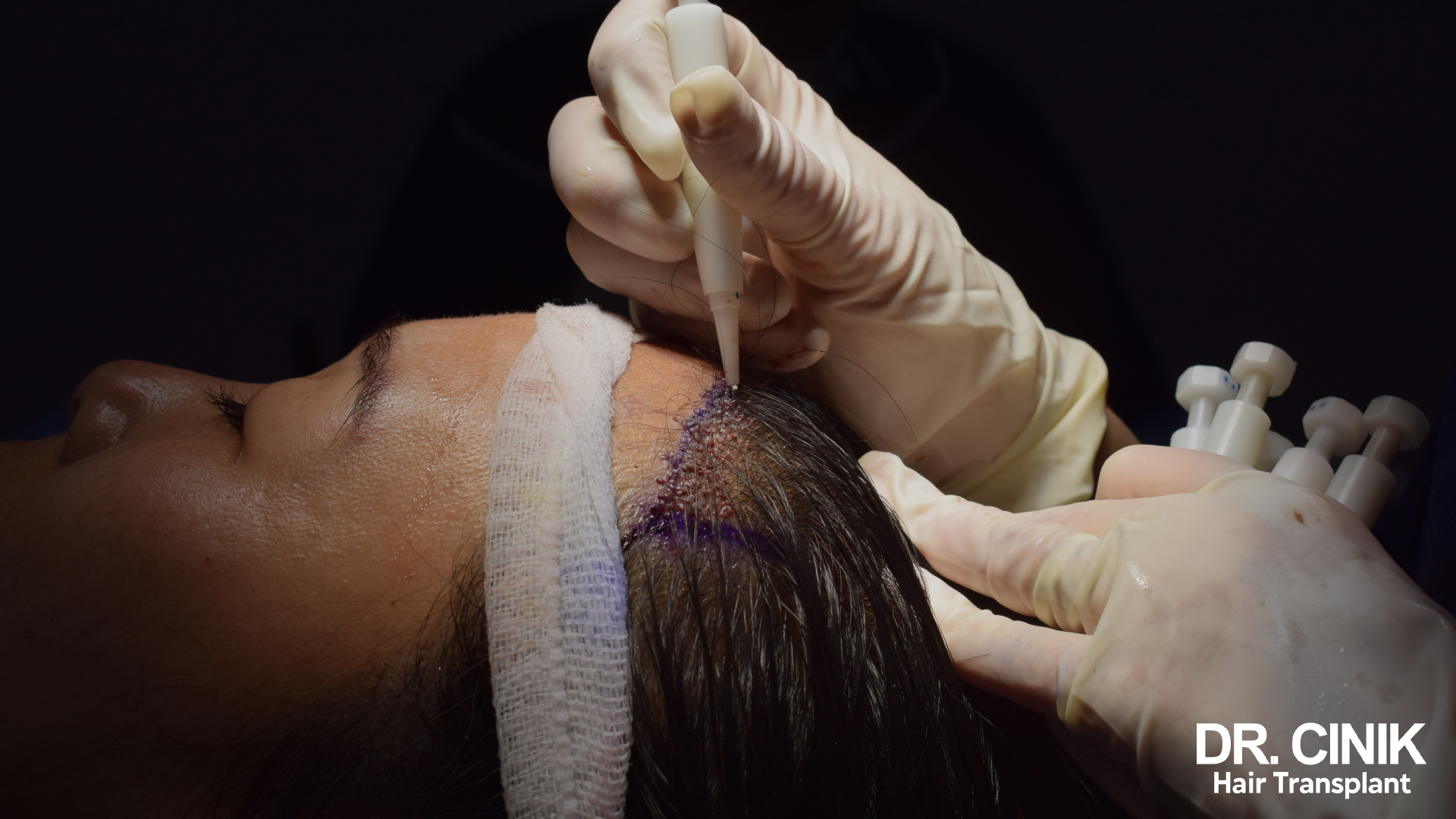
Specific Protocol for Women
A tailor-made protocol has been developed for women with androgenetic alopecia associated with endometriosis. This personalised approach takes into account the specific features of their condition and their aesthetic expectations.
The procedure begins with an in-depth consultation to assess the pattern and level of hair loss and then define an optimal implantation strategy. Particular attention is paid to the hairline, a key element in the natural appearance of women’s hair. A partial shaving technique is used, strategically preserving certain areas to maintain a socially acceptable appearance during the recovery period.
The implantation density is carefully calculated according to several factors: the quality of the donor area, the characteristics of the scalp, and the expected progression of androgenetic alopecia. The implantation angles are carefully chosen to create a harmonious and natural result, respecting the particularities of women’s hair.

Detailed Procedure
The procedure is carried out in several key stages under local anaesthetic, ensuring the patient’s comfort throughout:
- The pre-operative consultation phase is used to establish a personalised treatment plan and to design the future implant.
- The extraction of the grafts is carried out with microsurgical precision from the donor area, generally located at the back of the skull, where the follicles are genetically resistant to the influence of hormones.
- Direct Implantation is performed immediately after extraction, minimising graft storage time. The DHI Implanter is used to place each follicular unit with maximum precision.
The total duration of the procedure varies between 6 and 8 hours, depending on the size of the area to be treated and the number of grafts required. This meticulous procedure is carried out in optimal sterile conditions in a modern clinic.

Results and Recovery
Hair regrowth after a DHI transplant follows a precise timetable, and results develop progressively over the months. Personalised monitoring is provided throughout the process, with support tailored to the specific characteristics of endometriosis.
The first few days post-operatively (D1-D3) are characterised by a slight sensitivity of the scalp and the formation of micro-crusts around the implantation sites. Between D4 and D10, these crusts begin to fall off naturally. During this period, specific post-operative care and an adapted washing protocol are provided to optimise healing.
The shock loss phase generally occurs between the 2nd and 4th week. This stage is normal and temporary. The first signs of regrowth appear around the 3rd-4th month, with a gradual improvement in hair density. The final results are established between 12 and 18 months after the procedure, with an excellent regrowth rate of 90-95% of the grafts implanted (Mehedintu et al., 2014).

Why Choose Turkey and Dr Cinik’s Clinic?
Specific Expertise
Dr Cinik has established an international reputation in the treatment of female alopecia, particularly in patients with endometriosis. His expertise is based on an in-depth understanding of the interactions between hormonal imbalances and hair health.
The clinic has developed personalised protocols that take into account the specific characteristics of each patient. The experience acquired through thousands of procedures means that we can offer predictable, natural results, even in complex cases combining endometriosis and hair loss.

Practical Benefits
Choosing Turkey for a hair transplant offers a number of significant advantages:
The value for money is particularly attractive, with average prices of €3,000**, compared with €8,000-12,000 in France, without compromising on the quality of care. Dr Cinik’s all-inclusive package includes:
- Airport-clinic-hotel transfers
- Accommodation in selected partner establishments
- Full post-operative follow-up
- Necessary medicines and care products
- Assistance in French throughout your stay
Infrastructure
Dr Cinik’s clinic meets the highest international standards:
- JCI certification attesting to the excellence of medical practices
- State-of-the-art DHI equipment
- Highly qualified and specialised medical team
- Sterile environment complying with the strictest hospital standards

Practical Aspects
Preparation
Preparing patients with endometriosis for a hair transplant requires special attention. A complete protocol is put in place several weeks before the operation.
A complete hormonal check-up is carried out to accurately assess hormone levels and their impact on hair health. This assessment includes the measurement of androgens, oestrogens, progesterone and SHBG. This information is used to optimise the timing of the operation and adapt the surgical protocol (Owecka et al., 2024).
Certain hormone treatments associated with endometriosis may require temporary adjustments. Dr Cinik works with the treating gynaecologists to establish the best treatment schedule. Planning also takes into account the menstrual cycle, as certain periods are more favourable for the procedure in terms of bleeding and sensitivity.
Specific pre-operative recommendations include:
- Stopping anti-inflammatory drugs two weeks before the operation
- Optimising iron and vitamin intake
- Adopting a preparatory hair care routine
- Stress management using appropriate techniques
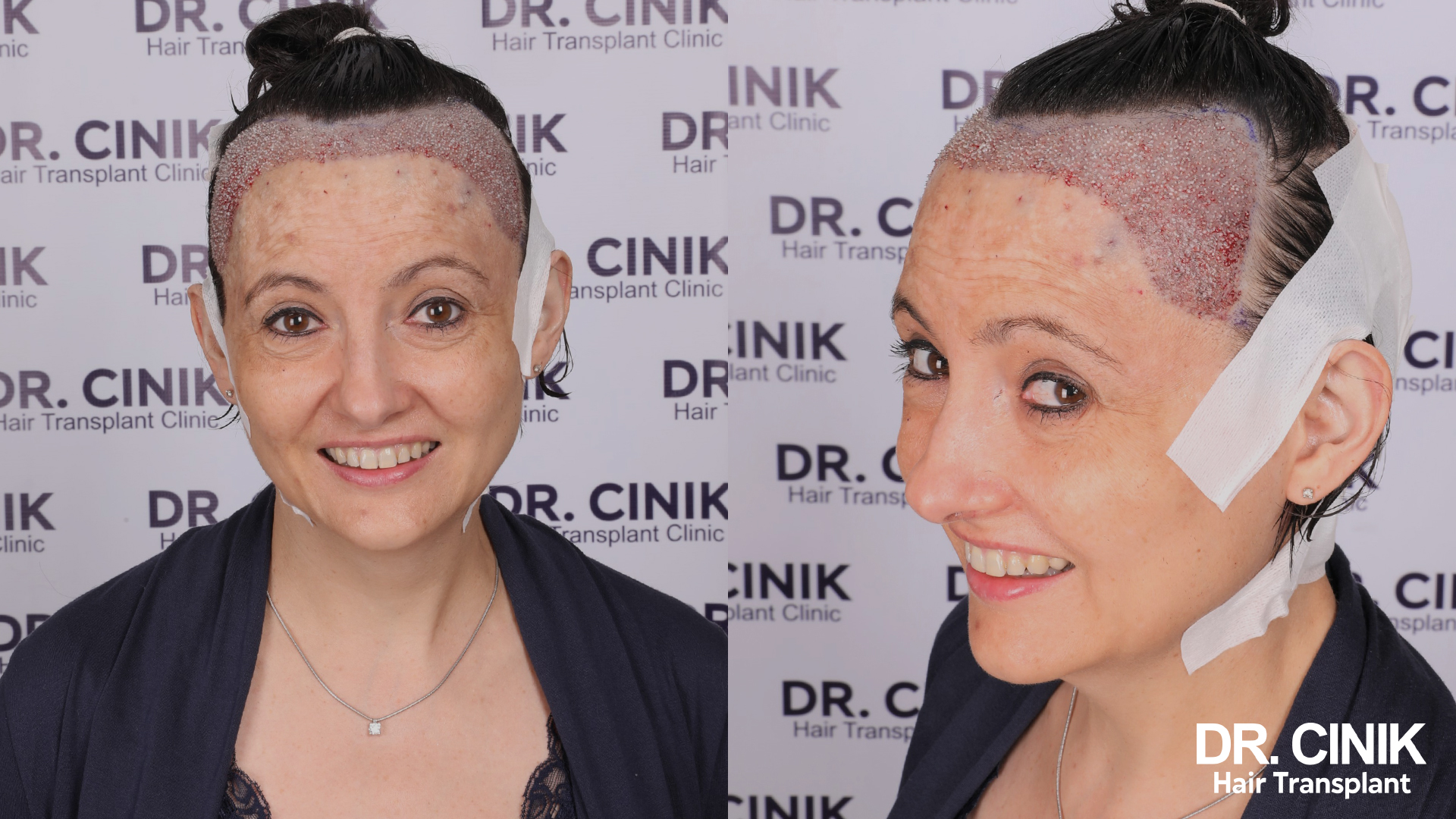
Post-transplant Follow-up
Post-transplant follow-up is particularly rigorous for patients with endometriosis. A specific care protocol has been developed to take account of the particularities of their condition.
The first few days are crucial to the success of the transplant. A detailed care protocol is provided, including:
- Precise instructions for washing and moisturising the scalp
- Recommendations for managing pain and discomfort
- A daily care schedule to be scrupulously followed
- Advice on optimising sleep and rest
Remote monitoring is provided by the medical team through:
- Regular video consultations
- 24/7 telephone support
- Photographic monitoring of progress
- Personalised adjustments to the protocol if necessary
Particular attention is paid to the management of post-transplant hormone treatments. The resumption of endometriosis treatments is coordinated with the treating doctors to optimise both hair recovery and the control of endometriosis symptoms.
Long-term support is provided, with regular check-ups during the 18 months following the operation. This period is used to monitor regrowth and adjust care to achieve the best possible results.

Conclusion
The association between endometriosis and hair loss is a complex problem requiring a comprehensive and personalised therapeutic approach. Our in-depth understanding of the hormonal mechanisms involved means that we can now offer solutions tailored to each situation.
It is important to distinguish between the different types of hair loss associated with endometriosis. While telogen effluvium, caused by stress and temporary hormonal imbalances, generally responds well to conventional medical treatments, androgenetic alopecia aggravated by endometriosis may require a more definitive intervention such as a hair transplant.
In this context, the DHI technique represents a major advance for the women concerned. This modern approach, combined with specific expertise in the care of patients suffering from endometriosis, makes it possible to achieve natural, lasting results. Successful treatment is based on several key factors:
- Accurate diagnosis and full assessment of the hormonal profile
- Careful planning of the operation in coordination with endometriosis treatments
- A cutting-edge surgical technique adapted to the specific characteristics of women’s hair
- Rigorous, personalised post-operative follow-up
Dr Cinik’s clinic in Istanbul offers a medical environment of excellence, combining technical expertise, personalised support and optimal value for money. This solution enables women affected by this dual problem to regain harmonious hair and renewed confidence.
Sources
- Shigesi, N., Kvaskoff, M., Kirtley, S., Feng, Q., Fang, H., Knight, J. C., … & Becker, C. M. (2019). The association between endometriosis and autoimmune diseases: a systematic review and meta-analysis. Human reproduction update, 25(4), 486-503.
- Mehedintu, C., Plotogea, M. N., Ionescu, S., & Antonovici, M. (2014). Endometriosis still a challenge. Journal of medicine and life, 7(3), 349.
- Grymowicz, M., Rudnicka, E., Podfigurna, A., Napierala, P., Smolarczyk, R., Smolarczyk, K., & Meczekalski, B. (2020). Hormonal effects on hair follicles. International journal of molecular sciences, 21(15), 5342.
- Owecka, B., Tomaszewska, A., Dobrzeniecki, K., & Owecki, M. (2024). The Hormonal Background of Hair Loss in Non-Scarring Alopecias. Biomedicines, 12(3), 513.
 en
en
